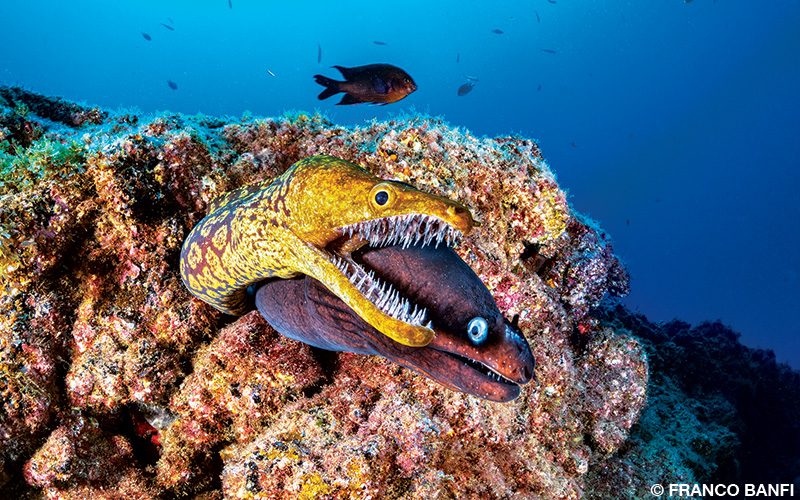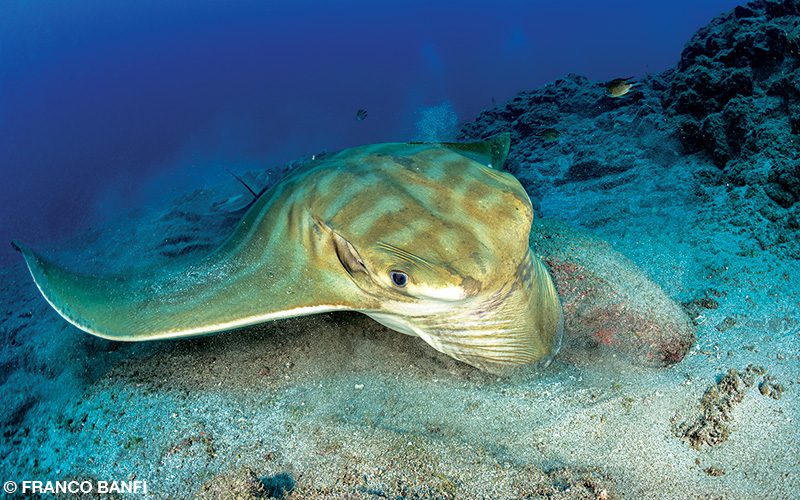The island of eternal spring
Tenerife looks powerful and magnificent in the shadow of the stratovolcano Mount Teide, which rises to an intimidating 12,198 feet (3,718 meters). It is the largest of the eight islands that form the Canary Islands archipelago, which is part of Spain but located off the coast of Africa near Morocco and Western Sahara. Often called the “island of eternal spring” because of its sunshine and pleasant climate throughout the entire year, Tenerife is reliable and affordable, and the diving is good all year. For travelers who are not interested in diving or water sports, Tenerife offers cultural, culinary, entertainment and leisure activities as well as numerous museums and historical sites. Picturesque villages, contrasting landscapes and superb sandy beaches fascinate even frequent globetrotting travelers. Declared a UNESCO World Heritage Site in 2007, Teide National Park is the most visited in Europe. The eponymous volcano is the highest mountain in Spain and the tallest point in the islands of the Atlantic Ocean.
The marine life thriving off the Canary Islands is a combination of North Atlantic, Mediterranean and endemic species. Ocean currents in the Atlantic ensure that water temperatures do not often drop below 64°F (18°C) even in winter, and these cooler temperatures are the critical factor in the lack of warmwater coral reefs and the limited diversity of tropical fish. The real stars here are different species of large stingrays and sea turtles.
Of the six species of marine turtles that divers can see in Tenerife, loggerheads are the most common. With a little luck visitors can sometimes observe the other five species migrating through the area’s waters — green and hawksbill turtles appear more often, but leatherbacks, olive ridley and Kemp’s ridley turtles appear with much less frequency. The smallest and rarest of all sea turtle species, the Kemp’s ridley is listed as critically endangered on the International Union for Conservation of Nature (IUCN) Red List.

In recent years the increasing popularity of scuba diving and underwater photography has provided biologists and researchers with new information about the island’s marine life. Other than stingrays (called chuchos by the locals) and sea turtles, we observed angel sharks (flat sharks that live on the sandy bottom), silvery-yellow grunts (roncadores), breams, jacks, scorpionfish, triggerfish, groupers, gobies, blennies and at least three species of moray eels. Invertebrate lovers can enjoy octopuses, cuttlefish, sponges, jellyfish, anemones, crabs, mollusks, sea urchins and more.
What I normally consider unusual is amazingly common in Tenerife. Our first dive was at The Bufadero. One of the more well-known dive sites, it is very close to the Port of Los Cristianos in southern Tenerife. It is relatively close to shore, but you need to dive from a boat. Green sea turtles start to approach divers at around 50 feet (15 meters). They tend to prefer shallow coastal waters (without cetaceans or dolphins) and are lured by areas rich in seagrass beds, one of their favorite food sources.
The sandy bottom is at 75 feet (23 meters), so I spend hours in the shallow water and have good experiences. One of the keys to success with marine life is to be patient and observe the animals’ behaviors, focusing on their movements and reactions to prepare for their approach. Upon our arrival at the slope, several green sea turtles gather together and swim among us at their ease. They are curious to see their reflections in camera domes and like to interact. Be respectful since you could also have a large and stubborn buddy for the rest of your dive. Green turtles can live approximately 80 years, measure 3 to 4 feet (1 to 1.2 meters) long and weigh 240 to 420 pounds (110 to 190 kilograms). Divers can also find breams, Atlantic trumpetfish, parrotfish, rays, barracuda and, in the right season, critically endangered angel sharks.
Cueva de las Morenas
We swim along the rocky seafloor at Cueva de las Morenas to the sandy bottom at 130 feet (40 meters) and see a large cave opening. In the darkness of the chamber we see a myriad of narwal shrimp (Plesionika narval), commonly called parapandalo, moving in a frenzy as our light shines on them.

Along the wall a lot of holes in the rock are home to a large population of moray eels of different species, some of which may share the same hole. You can sometimes spot the brown moray (Gymnothorax unicolor), the black moray (Muraena augusti) and the unusual fangtooth (or tiger) moray (Enchelycore anatina), which has a long snakelike body and an elongated mouth that goes back beyond its eyes. Its long teeth are visible even when its mouth is closed. It’s a hard-to-please client for the symbiotic shrimps or wrasses that clean its teeth. Observing and understanding the cleaning behaviors of the many creatures here is a fascinating activity, and each one has its own routine.
Over the wall is a plateau where we see many fishes and a rare bull ray (Aetomylaeus bovinus). Not much is known about this species, but they may be migratory like many members of the family Myliobatidae. They can grow to more than 7 feet (2 meters) and are easy to recognize by the shape of the head, with its long, flat, rounded snout.

La Arenita

For our next dive we travel further south to La Arenita, which you can reach from the ports at Los Cristianos, Puerto Colón and Marina del Sur. The seafloor here slopes gently downward, with rocky boulders and old lava flows until the sandy bottom at 130 feet (40 meters). It is sometimes possible to feel some current here, which is a significant factor for healthy Antipathes black coral — which is named for its black skeleton and appears orange-red on the outside. Lobsters sleep under the overhang and between the rocks, and some red spider crabs try to hide on the bottom.
Marine Mammals
Short-finned pilot whales (Globicephala macrorhynchus) can achieve impressive sprints on their foraging dives. I was hoping to photograph them on this trip. In the Canary archipelago, like in many other countries, some activities are forbidden for recreational divers. In-water interactions with wildlife and endangered marine mammals are limited to researchers and professional photographers who are committed to conservation projects, studies and identifications.
Divers and tourists can learn many things, however, by observing the behaviors of marine mammals swimming free in the open ocean, which provides a special and memorable experience. Many marine mammals congregate here, particularly whales, including orcas and sperm, beaked, fin and sei whales. Researchers claim that endangered Atlantic northern right whales (Eubalaena glacialis) and blue whales (Balaenoptera musculus) may occasionally make an appearance here.

Whale watching is a big part of the tourist economy in Tenerife, where researchers studying frequency and diversity have spotted 24 cetacean species. Their surveys indicate that the best weather conditions for whale-watching tours are on the southwest coast, which offers some protection from prevailing currents, making it a good area for both resident and visiting whales to find food and raise their calves.
While snorkeling with the whales, I took pictures of friendly families with adults and calves playing together and investigating the researchers at the surface. The whales are very social and have inquisitive attitudes. The pod has a strong bond and does everything together: resting, hunting, socializing, playing, traveling and burial.
It was heartbreaking to witness the pain of a pod in which two females were carrying their newborns (both were dead at birth) in the open ocean for days, reluctant to let go. Judging from the behavior of the dominant male and the other females of the family, the loss of the newborns affected the entire pod. Adult females swam closer to the two mothers, gently escorting them in their nowhere swim. The male kept us at a distance from the two females; he was never aggressive, but his intent in protecting the two mothers was clear. The pilot whales transmitted a great sadness that we couldn’t help but feel.
Topside Activities
There are a lot of choices when not diving. You can visit the laurel forest at the Rural de Anaga Park, take a walk along the low vineyards of Tacoronte-Acentejo and sample wine, or explore the many scenic hiking trails. Near Los Cristianos and Playa de las Americas a road full of hairpin turns leads to Vilaflor (and its forest of Canary pine trees) and to Mount Teide National Park, where you can see the wide Las Cañadas caldera that circles it. Inside the park you can visit the craters of Pico Viejo and Montaña Mostaza (two smaller peaks below Mount Teide), observe the strange rock formations called Roques de García and get a view of the mountain from la Cueva de Diego Hernández. Trekkers of different levels can find a suitable path for their skill set. Other activities include parasailing, windsurfing, golfing, horseback riding, cycling and more.

Wherever you go, Tenerife stands out for the ubiquitous presence of Mount Teide, with its peak of lunar appeal and colors. Forces of nature — the sun, ocean and volcanoes — and humans have designed the island’s scenery. For a fantastic view you can ride a cable car almost to the peak of Teide. When the nearly omnipresent blanket of clouds overhead lifts away, you can see the coast of Morocco 200 miles in the distance and the ocean around you that hides the 12,000 feet of an old volcano that reaches to the seafloor below.
How to Dive It
Getting there: The best way to get to Tenerife is to fly to Madrid, Spain, and from there to Tenerife North (TFN) or Tenerife South (TFS) airports. To get to the harbor, you can rent a car at the airport or take a taxi. Most dive sites must be reached by boat from one of the coastal ports. Tenerife has a wide range of accommodation options, including hotels, apartment rentals, camping, villas and more.

Conditions: The coastal climate is subtropical oceanic. It is very mild and sunny most of the year, and the little rainfall that occurs is typically from October to March. Prevailing winds are northeast trade winds. Diving and navigation are safe on the protected south side of the island. Diving takes place all year, but the best conditions are from May to November, when the average water temperatures range from 68°F to 75°F (20°C to 24°C). Depending on conditions, underwater visibility can often be more than 100 feet (30 meters).
Special thanks to Arona Son Atlántico and Ministerio para la Transición Ecológica y el Reto Demográfico for access to marine protected areas.
© Alert Diver — Q2 2020